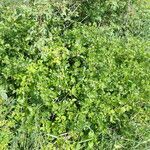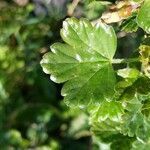Plants 1-1.5 m. Stems erect, pubescent; spines at nodes 3, 5-10 mm; prickles on internodes present, scattered. Leaves: petiole 1-2 cm, pubescent; blade pentangular, 3-5-lobed, deeply cleft, 2-5 cm, base cordate to broad-cuneate, surfaces pubescent, lobes obtuse, margins crenulate-dentate, apex obtuse. Inflorescences spreading, solitary flowers or 2-3-flowered racemes, 1-3 cm, axis glabrous or sparsely lanate and stipitate-glandular, flowers evenly spaced. Pedicels not jointed, 2-4 mm, glabrous or sparsely lanate; bracts ovate, 1-3 mm, sparsely lanate, sparsely stipitate-glandular. Flowers: hypanthium greenish, short-campanulate, 4-6 mm, pubescent; sepals not overlapping, spreading, greenish abaxially, pink adaxially, strap-shaped, 5-7 mm; petals not connivent, erect, white, ovate, not conspicuously revolute or inrolled, 2-3 mm; nectary disc not prominent; stamens 2 times longer than petals; filaments linear, 4-6 mm, glabrous; anthers cream, oblong-oval, 1-2 mm, apex rounded; ovary sparsely hairy; styles connate to tip, ca. 6 mm, villous in proximal 1/2. Berries very palatable, greenish, ovoid, 10-20 mm, softly bristled.
Stems with stout nodal spines, often also bristly; lvs to 6 cm wide; hypanthium broadly campanulate above the ovary, 3 mm long and wide, pubescent; sep pubescent, spreading or reflexed, round-obovate, 3.5–4 mm, longer than the hypanthium; pet 2–2.5 mm long and wide; stamens and style nearly or quite equaling the sep; fr pubescent and usually also with some gland-tipped bristles; 2n=16. Native of the Old World, occasionally escaped from cult. in our range. (R. grossularia; Grossularia reclinata)
A small thorny shrub. It loses its leaves during the year. It grows to 1-2 m tall. It spreads 1 m wide. The stems are thorny. The leaves are small and heart shaped. They have 3-5 lobes and teeth along the edges. The flowers are green. The fruit has a tough skin covered with spiky hairs. The fruit can be green or red.












